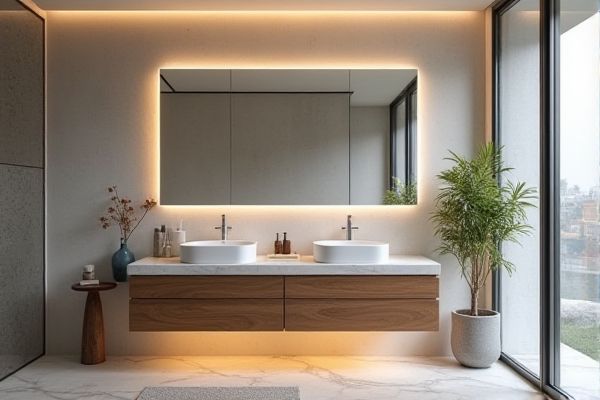
Floating vanities offer a modern, space-saving design by being wall-mounted, which creates an open floor area and makes cleaning easier. If you want to explore the key differences between floating and freestanding vanities to find the perfect fit for your bathroom style and functionality, keep reading.
Table of Comparison
| Feature | Floating Vanity | Freestanding Vanity |
|---|---|---|
| Installation | Mounted on wall, requires sturdy support | Placed directly on floor, easy to install |
| Floor Space | Leaves floor visible, creates open space | Occupies full floor footprint |
| Style | Modern, minimalist look | Traditional to contemporary styles |
| Cleaning | Easier floor cleaning under vanity | Floor cleaning around base needed |
| Storage | Limited storage space | Usually offers more storage capacity |
| Durability | Depends on wall integrity and mounting | Stable, durable floor contact |
| Common Materials | Wood composites, MDF, plywood | Solid wood, engineered wood, metal |
| Typical Sizes | 12" to 72" width | 18" to 72" width |
| Price Range | Moderate to high (EUR300 - EUR1500+) | Varies widely (EUR200 - EUR2000+) |
Introduction to Bathroom Vanity Styles
Floating vanities create a modern, minimalist aesthetic by being wall-mounted and providing open floor space beneath, which enhances bathroom accessibility and makes the room appear larger. Freestanding vanities offer a classic, versatile look with floor support, often featuring more storage options and easier installation due to their standalone design. Choosing between floating and freestanding vanities depends on bathroom size, style preferences, and functional needs such as storage capacity and ease of cleaning.
What is a Floating Vanity?
A floating vanity is a wall-mounted bathroom fixture that appears to hover above the floor, creating a sleek and modern aesthetic while maximizing floor space for easier cleaning. Unlike a freestanding vanity, which rests directly on the floor and often includes built-in storage below, a floating vanity provides an open area beneath, making small bathrooms feel more spacious and airy. Your choice between these vanities can influence both the design appeal and functionality of your bathroom.
What is a Freestanding Vanity?
A freestanding vanity is a bathroom cabinet that stands directly on the floor with four legs or a solid base, offering stability and easy installation without wall mounting. This type of vanity provides ample storage space and a classic, versatile design that fits various bathroom styles. Your choice of a freestanding vanity can enhance room aesthetics while maximizing functionality in smaller or traditional bathroom layouts.
Design Aesthetics: Modern vs Traditional
Floating vanities offer a sleek, modern design aesthetic with clean lines and a minimalist appearance that creates an airy, open feel in your bathroom. Freestanding vanities lean toward a traditional or classic look, featuring detailed cabinetry and a solid base that adds a sense of stability and timeless elegance. Choosing between the two depends on whether you want to emphasize contemporary style or maintain a conventional, warm atmosphere in your space.
Space Efficiency and Room Perception
Floating vanities maximize space efficiency by freeing up floor area, creating a more open and airy room perception in smaller bathrooms. Freestanding vanities, while offering significant storage options, can visually occupy more space and may make compact bathrooms feel crowded. Choosing a floating vanity enhances your bathroom's spaciousness, especially in tight layouts where maximizing floor visibility is essential.
Storage Capacity Comparison
Floating vanities offer a sleek, modern design with limited storage capacity due to their wall-mounted structure and open space beneath, making them ideal for smaller bathrooms or minimalist aesthetics. Freestanding vanities provide significantly greater storage capacity with multiple drawers and cabinets, accommodating larger bathroom essentials and supplies. Homeowners prioritizing ample storage often prefer freestanding vanities for their robust functionality and versatile storage solutions.
Installation and Maintenance Differences
Floating vanities require wall mounting with sturdy studs to support the weight, making installation more complex and often needing professional help. Maintenance for floating vanities includes regular checks on mounting hardware to prevent loosening over time. Freestanding vanities offer simpler installation as they rest on the floor without the need for wall anchors, allowing easier access for plumbing repairs and cleaning beneath the unit.
Cost Considerations: Floating vs Freestanding
Floating vanities generally cost more due to complex installation requirements and the need for wall reinforcement, while freestanding vanities offer more budget-friendly options with easier setup. Material choices and design complexity can further influence prices for both types, but freestanding vanities typically provide more affordable customization. Your decision should factor in both initial expenses and potential installation costs to find the best value for your bathroom renovation.
Durability and Water Resistance
Floating vanities offer superior water resistance due to their wall-mounted design, preventing water damage by keeping the base off the floor and reducing moisture exposure. Freestanding vanities, while often constructed from solid wood or engineered materials, can be more susceptible to water damage at the base and lower edges, especially in humid bathroom environments. Choosing materials like marine-grade plywood or sealed veneers enhances durability and water resistance for both vanity types, ensuring long-term performance in wet areas.
Best Applications: Which Vanity Suits Your Bathroom?
Floating vanities are ideal for small bathrooms or modern designs, as their wall-mounted structure creates an open floor space and adds a sleek, contemporary look. Freestanding vanities suit larger bathrooms or traditional styles, offering ample storage and the flexibility to be positioned anywhere in the room. Choosing between a floating or freestanding vanity depends on space constraints, desired aesthetics, and storage needs for optimal bathroom functionality.
 homyna.com
homyna.com